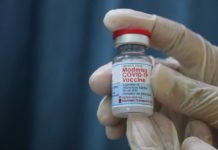Think the world has been turned upside down due to COVID-19? Wait until you get on your next cruise…

Cruising has been at the forefront of industries hit by the crisis. The good news is that trips have returned after more than 15 months of no sailing. But the virus is still out there and can find its way onto cruises — even ones sailing with vaccinated passengers.
So if you thought that once cruises set back to sailing everything would be back to normal, think again.
Cruise lines are going to go out of their way to keep passengers healthy on their vacation. Not only do they need to assure the CDC that their policies will keep people safe, but cruise lines are also under tremendous scrutiny from the public and the media. Any cases tied to cruise ships promise to be a big story.
For more than a year cruise lines and health authorities have made plans for cruising to keep passengers and crew safe. Those changes continue to evolve and will do so well into the future. However, with cruises now returning, it’s finally clear what the initial policies and adjustments are for life on the ship.
While many of these changes are in line with what you might expect, there are some more dramatic changes that will have an impact on your cruise.
Keep in mind that not every cruise line will have the exact same policies. As well, expect things to continue to change as the pandemic evolves. For now at least, here’s a good idea of the protocols you can expect if you’re cruising soon…
Vaccination Requirements

If you want to cruise, then you’ll need to get the shot. For many lines and many sailings, it is required of everyone that’s eligible (including kids of eligible ages). Most cruise lines — including Royal Caribbean, Carnival, and Norwegian Cruise Line — have implemented a shot requirement on many trips starting out.
That means if you want to sail, then you’ll most likely need to have both doses (if it’s a multiple dose) more than two weeks before setting sail. (Note: Small numbers of unvaccinated kids ineligible for the dose are allowed to board.)
Now, not every cruise requires vaccination. Specifically, trips from Florida can’t require passengers to be vaccinated due to state law. In that case, unvaccinated passengers (or those who won’t show proof of the shot) can board, but they will have to undergo a number of tests before and during the cruise.
Testing for Passengers
Vaccinated? If so, then the CDC doesn’t require you to be tested before boarding or during the trip, assuming you aren’t showing any COVID symptoms. Cruise lines still have the option to test if they’d like. If sailing without the shot, it’s a different story.
In this case, cruise lines have made it clear that right now they will require multiple tests. For instance, Carnival is requiring those few people sailing its vaccinated cruises without the shot to have a negative test within 72 hours of sailing, at the pier during embarkation, and to be tested within 24 hours before the end of the cruise.
If eligible for the shot but sailing unvaccinated, then expect a hefty charge for the testing. Royal Caribbean has said kids who can’t receive the vaccine aren’t charged for testing, but those who choose to sail unvaccinated will have to pay nearly $140 for the required tests (nearly $180 if on a cruise of six nights or longer).
Mask Wearing
Perhaps no symbol of the pandemic has been more powerful than facemasks. Rules requiring them are easing in most locations, including cruise ships. However, you’ll still want to bring them with you.
CDC rules require masks in places like terminals. As well, indoor areas of the cruise ship will see mask rules in place for unvaccinated travelers. They are not required outdoors or in cabins.
If sailing a fully-vaccinated cruise (95%+ of passengers have the shot), then masks aren’t required around the ship. If sailing on a cruise below that threshold, then there can be dedicated spots only for vaccinated passengers where masks aren’t required.
Distancing
Similar to masks, there are rules for distancing, but they vary based on whether the ship has 95% or more of passengers vaccinated.
In short, if sailing a cruise below that 95% threshold, then expect distancing rules in place all around the ship. This includes everything from restaurants to casinos, theaters and more. Trips above the threshold aren’t required to have distancing rules in place, but it is recommended. Don’t be surprised if more space is provided to everyone, even if vaccinated.
And just like with masks, cruise ships can designate areas that are only for vaccinated passengers where distancing rules are relaxed.
Lots More Sanitation
It shouldn’t be a surprise that cruise lines are planning to increase the amount of sanitation on the ship. Increased cleaning in public areas is a basic first step to keeping passengers healthy.
With thousands of people on a ship, the public areas like elevators, bars, restaurants, lounges, and staircases are all frequent touch points that have many people passing through around the clock.
MSC, for example, says it will employ “new cleaning methods including the use of hospital-grade disinfectants, electrostatic sprayers, increased cleaning frequency and a focus on high-traffic, frequently-touched areas.”
Norwegian Cruise Line says on its ships “comprehensive enhanced cleaning and sanitation protocols, using EPA approved disinfectants, have been implemented throughout the cruise experience.”
Air Filtration Across the Ship
This pandemic has made us all highly aware of the air around us. Avoiding indoor spaces is now common. Instead, many opt for outdoor venues where there is fresh air.
Of course, if you are on a cruise ship, avoiding being inside is impossible. After all, you can’t sleep for the night on the pool deck. That’s why cruise ships are moving to more filtration for the air streamed throughout the ship.
Norwegian Cruise Line, for example, has said it will use a purification system to remove 99.9% of airborne pathogens — including COVID. That should help you to breathe easier.
Reduced Capacity On the Ship

At least at first, a number of lines are sharply reducing the number of passengers on the ship. Don’t expect these policies to stick around forever, but initial trips are sailing with lower capacities. For example, Celebrity Edge sailed the first cruise back from the United States at roughly 40% capacity.
Virgin Voyages has said that it will be “managing personal space by significantly reducing our overall ship capacity for our start-up sailing period.” There was no specific number given for how much capacity will be cut.
This move is likely to have a major impact on the financials of sailing. If cruises return and prove that they can sail safely, expect full capacity to come back quickly.
New Muster Drills
With the virus, cruise ships have had to rethink how they do a lot of things. One area that’s getting a makeover is the muster drill. This safety drill performed at the beginning of the trip used to see everything on the ship stop, passengers all congregate in their designated area, and then stay there while listening to a safety briefing.
Obviously passengers all lined up next to one another is a bad idea these days. Instead, cruise lines are implementing a digital solution. Now, passengers can watch a safety demonstration through the cruise line app or on the stateroom television — instead of having to meet in a large group. Then, they head down to their muster station to check-in with a crew member.
Not only does this mean better distancing, but passengers can complete the process at their own pace (but still at the start of the trip).
Shore Excursions

While so much time is spent on the cruise ship, there are also ports of call. And in these ports there is the mixing of cruise passengers with the local population. This represents a risk for both sides as cases could potentially be brought to shore or picked up from foreign ports.
Independent exploration for vaccinated passengers is allowed, but cruise lines are still taking precautions. At some ports shore excursion “bubbles” are still in place where only approved excursions are allowed to reduce the risk of passengers. Private islands seem to have looser restrictions since the cruise line has some measure of control.
Of course, restrictions are tougher on unvaccinated passengers, with approved excursions largely being the rule unless heading to a spot like a private island.
Other Adjustments
Depending on each cruise line’s specific policies, don’t be surprised if you see other adjustments to life on the ship. There could be features or venues that the cruise line closes down or in other ways adjusts for the health of passengers.
For example, on at least one cruise Carnival has decided to keep the kid’s areas on the ship closed for the few kids that are allowed to sail unvaccinated. Given that children are not eligible for the vaccine, keeping them from congregating in these areas should reduce risk, even though kids are tested multiple times to board.
Royal Caribbean, meanwhile, has said that unvaccinated passengers will have restricted access to some areas, including the casino and spa.
Policies Will Continue to Evolve
There is no doubt that as time goes on, the changes in place will continue to adjust. Assuming that vaccinations continue to roll out and reduce the number and severity of cases, it wouldn’t be surprising to see many of these changes lifted. However, for the time being, expect a “new normal” with cruising.
The good news? For vaccinated passengers on highly-vaccinated cruises, many aspects of the trip will be similar to how things were before the pause. That said, don’t expect everything to be exactly the same.












